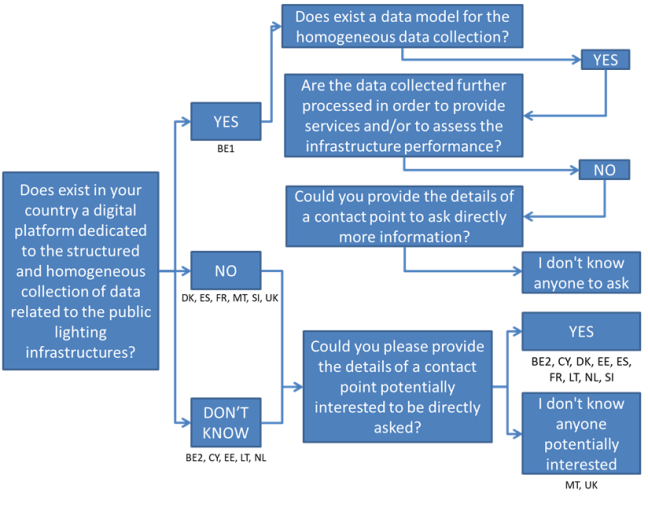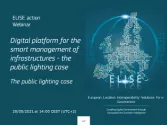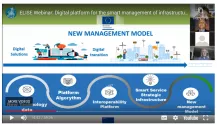Back to Energy & Location Applications

The management of public lighting often represents a challenge for most of the Local Administrations in terms of costly energy bills, inefficient maintenance and lost opportunities to offer additional services to the citizens reusing public lighting infrastructures (e.g. Wi-Fi hot spots).
In this use case, one of the several developed under the Energy & Location Applications , the PELL project is deeply analysed to come up with good practices in Europe related to the "smart management" of public lighting systems. PELL is being gradually implemented by 8.000+ Italian Municipalities, has made it possible to create, through the definition of a specific data model, a digital platform for the structured and harmonised collection of the georeferenced identity data the Public Lighting for each Municipality.
In the following sections we provide more information on the use case "Digital platforms for smart management of public lighting".
- To identify existing good practices in Europe related to the "smart management" of public lighting systems, similar to the good practice being implemented in Italy by ENEA (Italian National Agency for New Technologies, Energy and Sustainable Economic Development) with the support of AgID (Agency for Digital Italy), through the PELL - Public Energy Living Lab project.
- To outline a possible methodology to be applied at the European level for the smart management of public lighting systems, based on a comparative analysis of the good practices identified.
The management of public lighting often represents a challenge for most of the Local Administrations in terms of costly energy bills, inefficient maintenance and lost opportunities to offer additional services to the citizens reusing public lighting infrastructures (e.g. Wi-Fi hot spots)
Some facts and figures related to the situation in Italy:
- 9 million light points estimated in the whole country, of which a large part is below the efficiency threshold;
- 5.995 GWh is their estimated annual energy consumption (referred to 2018);
- 40-60% is the estimated energy saving ratio, considering only the upgrading of the installations (LED);
- 60-70% is the estimated energy saving ratio, also considering adaptive remote management.
The PELL project, being gradually implemented by 8.000+ Italian Municipalities, has made it possible to create, through the definition of a specific data model, a digital platform for the structured and harmonised collection of the georeferenced identity data the Public Lighting for each Municipality.
The platform operates into two steps:
- Step one: thanks to specific algorithms, it collects, organizes, processes and integrates technical infrastructure data with consumption data, using a data model developed by AgID and providing consumption monitoring through a Smart Meter;
- Step two: using key performance indicators, it checks, assesses and validates the infrastructure operation (monitoring electrical parameters and energy consumption) and suggests solutions to upgrade it, providing the related intervention costs.
Launched in July 2019, PELL has collected 93.090 light points thanks to 14 Italian municipalities joining the platform.
The use case has been broken down into the following steps:
- Preparation and running of a survey at the European level concerning the state-of-the-art of the "smart management" of public lighting systems,
- Assessment of the survey results, aimed at identifying other possible good practices (besides the one related to PELL project in Italy),
- Comparative analysis of the best practices, aimed at identifying advantages and disadvantages of a possible harmonization at the EU level of the methodologies implemented in the national good practices,
- Identification of a possible methodology to be applied at the EU level for public lighting systems smart management.
The survey was structured to collect information about digital platforms similar to PELL in Europe and their main characteristics.It was carried out in 2018 with the support of the members of the ISA2 Working Group on Geospatial Solutions, who represented the natural first contact point asked to explore the situation in their Member State and provide possible additional contact points to be contacted by the Joint Research Centre team.

Twelve replies from eleven countries were collected (two from Belgium and one from Cyprus, Denmark, Estonia, France, Latvia, Malta, Netherlands, Slovenia, Spain, United Kingdom).
Although the investigations were not exhaustive, no good practices similar to the Italian one emerged in the twelve countries analysed.Therefore, the PELL project was, at least at the time of the data collection, the only good practice for the smart management of public lighting and its reuse at the EU level was analysed.
The analysis focused on the data model developed by AgID, available as a conceptual model (described in a pdf document in Italian) and as a physical model in the form of a GML application schema (XSD file with attributes name in English). An HTML implementation guide, an online validator and a Schematron file containing semantic rules, all in Italian, are also available, together with examples and additional supporting material.
It is worth noting that the data model developed by AgiD is perfectly integrated and interoperable with other geospatial data models, in particular with the technical rules on topographic databases in use in the Italian regions, in a context fully compliant to the Once-only principle. All technical rules are published in the national catalogue of geospatial data.
After having analysed the PELL data model, the easiest solution proposed for its reusability in other EU countries would be performing a slight adaptation of the current schema to create an extension of the relevant INSPIRE schemas of Utility and Governmental Services theme.
This solution would minimise the effort of data providers already familiar with the related INSPIRE core schemas. It has not been implemented yet, waiting for an exhaustive investigation on the existence of good practices for the smart management of public lighting in Europe, to be carried out in a possible next step.
Besides the solidity of the above-mentioned data model, the PELL digital platform has the advantage to represent also a solution to reorganise and modernise the management processes and the entire decision support system in the public lighting sector. The platform will also allow providing services based on public lighting infrastructures (e.g. Wi-Fi hot spots, cameras).
At present, PELL provides strategic support to different stakeholders:
- infrastructure managers willing to use a professional, transparent and dynamic platform;
- policymakers willing to encourage the adoption of enhanced innovative services;
- project finance experts involved in assessing the bankability of projects and in the monitoring of investment risk.
Thanks to its versatility, the vertical platform could also be used to monitor other energy-intensive public services, such as confined lighting and energy consumption in public buildings.
At present, the platform reuse is focused on public school buildings and hospitals and Smart Services (services that refer to Smart City, and in particular:
- "Integrated" services to the Public Lighting infrastructure with differentiation into
- functional service for public lighting;
- systems integrated with the Public Lighting infrastructure (e.g. Video camera);
- Mobility services;
- Services for the safety and well-being of citizens;
- Services for public administration with the development of a dedicated data model. Next, PELL will also be implemented for the Sources of Water (Sources of Water is referred to as the Water network of potable water).
The benefits of the PELL digital platform have been described in the previous sub-section.
The reuse of the PELL digital platform in other EU countries could generate the same benefits, addressing the following target groups:
- Local Administrations interested to understand how to reduce the energy bills and the maintenance costs related to public lighting,
- Regional/National Administrations interested to understand how to adopt a digital platform for the smart management of public lighting in a public procurement context and to know the constancy of the infrastructure on a national scale to implement financing actions,
- Companies working in the energy efficiency sector, interested in increasing their competitiveness, thanks to the use of a common digital platform for public lighting,
- Professionals willing to reskill/upskill regarding the use of the digital platform for public lighting,
- Citizens, interested in understanding how the public lighting infrastructures and services can be improved and innovated (e.g. Wi-Fi hot spots, cameras).
Furthermore, the adhesion to the PELL by the Public Administration contributes to:
- rehabilitating the Public Lighting infrastructure to its original role and in the perspective of a vector of intelligent technologies and services;
- transforming it into a reference asset for the transition to the Smart City - Infrastructure / Digital;
- integrating it and using it for the construction of Energy Communities;
- digitising the information assets of the IP;
- building the first national database of strategic infrastructures;
- sharing and disseminating data;
- becoming an integral part of the innovation network of urban management models.



